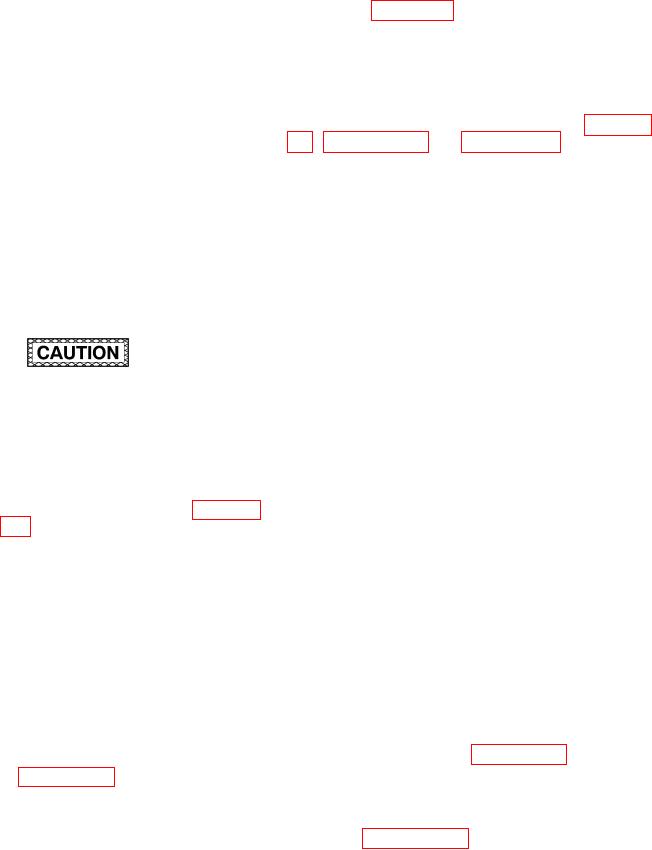
TM 1-1500-204-23-11
7-6. ADHESIVE BONDED JOINTS. To ensure the
(k) Install prepackaged adhesive into the
dispensing gun or pour adhesive into
paste adhesive adequately wets the surfaces to be
plastic syringe.
bonded, it is important to apply paste adhesive to both
surfaces. Bondline thickness is important to control
when using paste adhesives to preclude reduced
(l)
Insert the tip of the nozzle all the way
strength and unacceptable porosity. After applying
into the hole.
adhesive to the part and patch surfaces, an adhesive
comb (see igure 3-27) is used to remove excess
(m) Dispense adhesive into the cavity from
adhesive and provide the correct amount of adhesive
the bottom of the cavity working up to
on the surfaces to be bonded. On some adhesives
the skin hole.
scrim cloth is applied over the adhesive on the
part surface prior to installing the patch to prevent
(n) Once the cavity is illed continue to
excessive adhesive squeeze out during the cure cycle.
dispense the adhesive into the hole
Refer to the system speciic technical manual on
so that excess lows out of the hole
whether scrim cloth is required. Refer to paragraph
along the side of the nozzle bringing out
7-3, paragraph 7-5, or paragraph 6-5 for Process
entrapped air.
Flow Diagrams for adhesive bonded repairs.
(o) Completely remove the nozzle from the
a. Facilities, Equipment and Materials. The fol-
hole while dispensing adhesive.
lowing equipment and materials are required: Vacuum
Cleaner, HEPA Filter, Heat Blanket, Temperature/Vac-
(p) Remove excess adhesive from the sur-
uum Controller, Adhesive Comb, Flash breaker Tape,
face of the panel with a clean wiping
Adhesive, Paste (See System Speciic Technical Man-
cloth and solvent.
ual), Patch (See System Speciic Technical Manual),
Scrim Cloth, if required, Solvent, Silicon Carbide Abra-
(q) Place a small piece of lash breaker tape
sive Paper, Wiping Cloth.
over the hole.
b. Adhesive Bonded Joints Procedure.
(1) If the paste adhesive is in refrigerated stor-
age, remove and allow the material to reach
Failure to properly cure adhesive in accor-
room temperature before opening the con-
dance with the speciied cure cycle will result in
tainers.
reduced repair strength may not be detectable
by visual or nondestructive inspection. This
may result in loss of structural integrity.
NOTE
Ensure expiration of the shelf life marked
(r)
Using a temperature controller and heat
on paste adhesive containers has not been
blanket, cure according to paragraph
exceeded.
6-19 the system speciic technical man-
ual or the manufacturer s cure proile
(2) If required and using the patch as a guide,
per engineering disposition. An alter-
cut a piece of scrim cloth 0.25 inch larger
nate cure is at room temperature for the
than the repair patch periphery. If stacked
time speciied from the system speciic
patches are required for the repair, cut sep-
technical manual or adhesive manufac-
arate layers of scrim cloth 0.25 inch larger
turer per engineering.
than each succeeding patch in the stack.
(s) Drill appropriate sized hole for fastener.
(3) Apply solvent to a clean, dry wiping cloth.
Wipe clean the adhesive comb. Allow to air
(t)
Vacuum the repair area and then wipe
dry for 30 minutes.
with clean wiping cloth to remove drilling
dust.
(4) Prepare the part and patch surface for bond-
ing according to paragraph 6-7 and the sys-
(u) Perform NDI of densiied area according
tem speciic technical manual.
to paragraph 5-2 and the system spe-
ciic technical manual to verify integrity.
(5) Prepare approximately 50 grams of paste
adhesive for patch bond as described in
7-31

